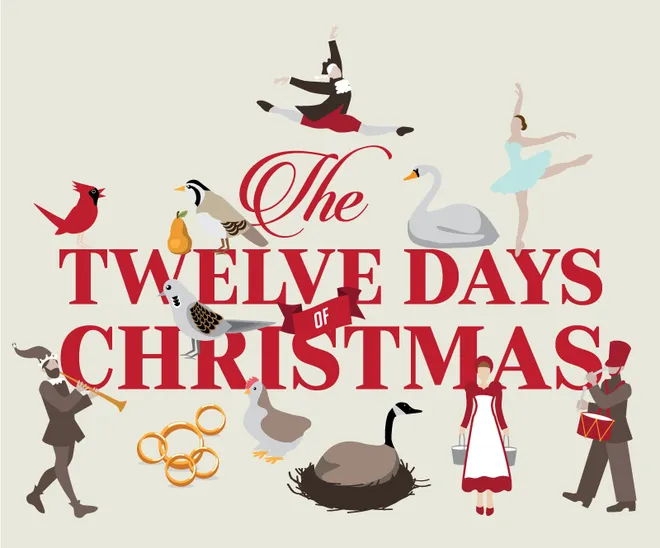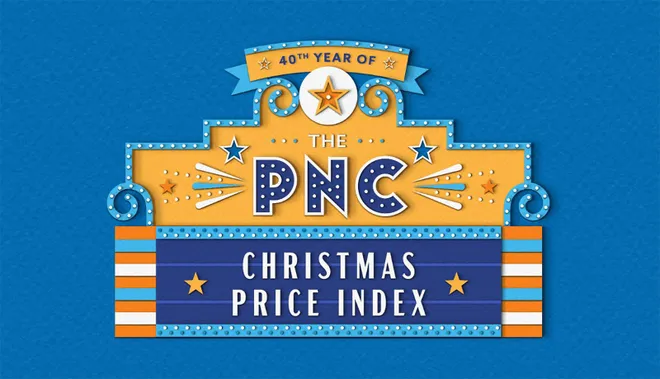How much for the two turtle doves, please? Unpacking the real cost of 12 Days of Christmas
Shoppers may be angry about high prices for gifts this holiday season. The good news, though, is that they're not likely buying much, if anything, on the popular "The Twelve Days of Christmas" list.
When's the last time you spotted two turtle doves, three French hens or four calling birds on anyone's wish list?
And five gold rings? Isn't one ring plenty for your true love to send to you?
What price is true love? Or a partridge?
Buying all 12 categories of gifts rattled off in the popular, but incredibly annoying Christmas song would cost you $46,729.86 this year, according to PNC Bank's 40th annual Christmas Price Index, which is a light-hearted take on the consumer price index. (The true cost of Christmas in the song − say if you kept buying two turtle doves repeatedly each time it was mentioned in the song, along with all the other items repeatedly mentioned, would add up to nearly $202,000.)
Protect your assets: Best high-yield savings accounts of 2023
The collective price hike was 2.7% for the items in the song − including those six geese a-laying, seven swans a-swimming, and eight maids a-milking − if you're not buying the same things repeatedly. This year, all that stuff would take an extra $1,206.59 out of your checkbook.
It adds up −including the nine ladies dancing, 10 lords a-leaping, 11 pipers piping and 12 drummers drumming − to a bit less than the average price of a new car or truck. The average price paid for a new vehicle was $47,936, according to October data from Kelley Blue Book.
Me? Get me a big red bow on the hood, put a little puppy on those leather seats, tuck a few Starbucks gift cards in the glove compartment, and I'd say my true love and I are good to go. Whatever, those gifts aren't in the song so we'll price a partridge in a pear tree. (Bird in 2023: $20.18, same as a year ago. Flowering pear tree: $299, up 15%.)

What is fun about the PNC Christmas index, though, is that it gives you a festive glimpse into inflation.
Unlike gold prices, gold rings didn't skyrocket in price
"Gold never goes out of style, but apparently plain gold bands do," according to the PNC Christmas Index. "The price for Five Gold Rings stayed flat for the first time in more than five years."
Amanda Agati, chief investment officer for PNC Asset Management Group, told me that jewelers are likely finding that consumer demand for gold rings isn't as strong in 2023 as earlier years, and they're not seeing the same amount of foot traffic as in the past.
"Increasing the price of the rings is not going to clear the inventory off their shelves," she said. "So, they didn't move prices up on a year over year basis."
In spite of a dramatic fallout in October, gold prices are up overall in 2023. The price of gold traded at $2,037.74 per troy ounce Dec. 1 early in the day. That's up 10.8% year over year.
This week, gold touched an all-time high when it was trading above $2,135 an ounce on Monday in London.
But PNC Christmas Price Index looks at five gold rings, like you'll hear over and over again in the song, not the price of the commodity.
"What we're pricing is the actual gold ring itself," she said.
PNC surveys a number of jewelers to gauge the market and tries to maintain the same sources for consistency.
Four calling birds didn't soar in price
Seeing a price hike of 2.7% for the entire basket of goods and services offered in the Twelve Days of Christmas sounds like practically a bargain these days. And that's especially true next to last year's hefty, Santa-sized 10.5% price hike for those 12 gifts.
By contrast, the official Consumer Price Index was up 3.2% in October, year over year, according to the U.S. Bureau of Labor Statistics.
Two turtle doves spiked in price by 25% to cost $750 in 2023. But some items saw their prices stay flat, or a 0% price hike − the partridge, the four calling birds, the five gold rings, the seven swans a-swimming, the eight maids a-milking, and the nine ladies dancing.
The swans are pricy at $13,125.
The price for the six geese flew up by 8.3% to $780. And since 2018, those geese have grown in total price by almost $500.
But any shopper can tell you the real problem is all those repeated price increases strung together.
The same 12 gifts had a collective price tag of $38,993.59 in 2019, according to the PNC calculations. We're talking about a gain of 19.84% in just four years.
The gifts had a price tag of $20,023.58 back in 1984. And yes, the index was down significantly in price in some years − such as in 1995 when it was down 26.3% and the collective cost was $17,915.25. (The price of swans tumbled by 50% that year, reportedly due to a successful Trumpeter swan breeding program.)

PNC's Agati explained that some prices reflect key parts of the economy, such as continued higher inflation for the price of services. The cost of 11 pipers piping went up 6.2% − reflecting a tight labor market and the cost of hiring musicians, as well as the costs associated with putting on the performance.
If wages went up at many companies, why did the price of eight maids a-milking stay the same?
The reason, she said, is that the cost for the maids a-milking is measured by the federal minimum wage, which remained the same at $7.25 an hour. The cost of the maids remained at $58 this holiday season, reflecting one hour of pay for each of the eight maids.
The cost of those 10 lords a-leaping went up 4% year over year to $14,539.20 in 2023, reflecting the significant moves in contractual increases in wages. "It doesn't have anything to do with gender pay or any kind of gap," Agati said.
Many holiday shoppers bank on bargains that they find while shopping online. But the goods and services being tracked in the PNC Christmas Price Index actually trigger higher costs when the items are bought online, according to Agati. The high prices often reflect extra costs for shipping, handling and even insurance.
The cost of the five gold rings in the PNC index, for example, skyrocketed by nearly 35% year over year when shopping online.
The five gold rings bought in the store were flat in price at $1,245. It was the first time in more than five years that the price stayed flat.
But online the cost jumped from $1,089.75 last year to $1,469.75 this year.
Agati noted that the traditional version of the Christmas Price Index is up 2.7% year over year. But the overall basket of prices for the internet version of the same index is up 4.8%.
“It’s funny because everyone assumes shopping online, you’re going to get a deal,” Agati said. But the items in the song aren’t sold everywhere; it’s an extremely unique gift basket.
"You don't get a lot of free shipping," she said.
AI shopping help:Stuck on holiday gifts? What happened when I used AI to help with Christmas shopping
Credit card debt:The holidays are here. So is record credit card debt. How 6 Americans are coping.
Consumers want discounts and relief from high prices
Pricing these unusual goods, though, can give some insight into consumer behavior.
This holiday season, she said, shows the pressure that consumers are feeling from inflation, indicating a somewhat pull back in spending, especially for some higher-priced goods.
The flip side, Agati said, is that lower priced items, like some toys such as Barbie, remain hot this holiday season.
Many retailers are highlighting gifts priced at $20 or less or even $35 and less this holiday season, trying to attract a budget stretched consumer.
Many higher end goods, though, aren't flying off the shelves. When you look at sales trends related to jewelry or iPhones or appliances, even car sales, she said, they've all slowed.
"The consumer is still spending but not at the rate that we've seen in the last few years," Agati said.
PNC's forecast is that the U.S. economy will tip into a very mild recession starting in mid-2024, as high interest rates continue to weigh on the consumer and the economy.
"Consumers have been enduring a lot these last few years," Agati said. "On the one hand at the onset of the pandemic, we put so much stimulus, liquidity, cash in the hands of consumers and it did what it was intended to do, which was create (a) floor in an unprecedented environment."
Some of that money is still around to support spending and the economy, she said, leaving many consumers in pretty good shape.
Yet, we're now seeing more consumers turning to credit cards and other loans to keep buying.
Black Friday and Cyber Monday had record sales online. But Agati stressed that retailers are getting consumers to spend by offering extensive sales and significant discounting, albeit off some extraordinarily high regular prices.
"It seems like every day is Cyber Monday."
Consumer spending has been a key part of driving economic growth but, she suggests that's likely to cool off going forward. "We want to have a good handle on 'Is the consumer going to hang in there or not?' "
Her hunch: "I think the consumer is going to start to take a breath here."
Back in 2017, PNC noted that the relatively small price hike overall for the 12 gifts of less than 1% reflected a world where companies appeared "hesitant to pass through price increases to the consumer."
Not so much in the past few years.
Shoppers can tell you that everyone seemed only too willing in recent years to raise their prices. But Agati sees some signs where retailers don't have the pricing power that they have had in past years − and that could be what we're seeing in those five gold rings.
Contact personal finance columnist Susan Tompor: stompor@freepress.com. Follow her on X (Twitter) @tompor.
Disclaimer: The copyright of this article belongs to the original author. Reposting this article is solely for the purpose of information dissemination and does not constitute any investment advice. If there is any infringement, please contact us immediately. We will make corrections or deletions as necessary. Thank you.







